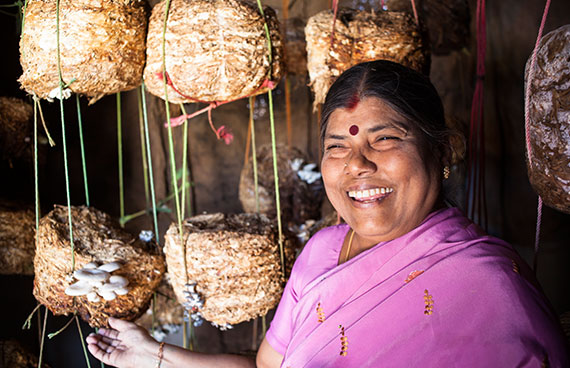An Oyster of Change
My Story
(As narrated by Sujatha’s husband R.B. Murthy)
Sujatha lived in the tiny village of Bethalapally in Tamil Nadu. The area is close to Hosur where most of the menfolk work in factories. The women mostly stay at home, and Sujatha was just another housewife. She couldn’t imagine being anything else. Her story started more out of curiosity than anything else.
We were close to the TVS factory at Hosur, so SST decided to send community workers to our villages. Social workers would encourage us to keep the villages clean and form self-help groups so we could motivate each other, collect garbage and recycle waste to bring in funds. Our surroundings were clean, we had fewer diseases, but then we wanted more.
Sujatha had little, except a small kitchen garden. A social worker from SST asked her if she would like to produce mushrooms — a lucrative crop.
Sujatha knew nothing of mushroom cultivation. She, however, was adventurous and volunteered to attend a two-day training camp organised by SST at a government research centre nearby. It proved to be the turning point. The experience taught her how to grow, harvest, and sell mushrooms.
Next, Sujatha took a loan from the bank. SST workers helped her with the loan application. She bought a few seeds and planted them on our terrace. In three weeks, she made Rs. 4,500.
As Sujatha grew more confident, she approached an SST self-help group for a loan of Rs. 20,000 to boost cultivation.
Soon, she was selling mushrooms worth Rs. 6,000 a month. Sujatha added a floor to our house, sent her granddaughter to a private school and bought enough gold for her daughter’s wedding. I’m proud of her.
SST also enrolled her for an intensive course in farming, and Sujatha, in turn, taught eight other women how to be independent. That’s real empowerment.
The SST Way
SST social worker A. Jayapaul who mentored the late Sujatha Murthy
Sujatha was part of a self-help group in her village. SST workers came across her in meetings. People usually ask us for loans and try to put their money in some income-generation programs that SST supports. SST tries to use local resources and motivate people. Sujatha was also looking at ways to make money.
We did research at the local level and found that there was demand for protein-based food. As there’s a substantial population that’s vegetarian, mushrooms are a protein-source for them. SST workers observed the local market and felt there was a good demand for oyster mushrooms. SST was confident that mushroom cultivation would fit in well. Experts, too, at the local agriculture college agreed.
It was hard work at first. Most villagers feared financial ruin and SST had to create a climate of trust. SST highlighted the fact that mushroom cultivation does not involve much labour. SST also helped with marketing by tying up with local stores for distribution. SST introduced the villagers in Paiyur to experts from the local agriculture college.
Sujatha was always enthusiastic. While others thought mushroom cultivation was fraught with risk, she embraced the idea from the start. She was among those who also attended a two-day training program at the agriculture university at Ootacamund.
Sujatha was the first to get into mushroom farming. Her husband supported her and was very understanding. His encouragement was a great advantage.
Sujatha, in turn, motivated others by telling them how her life had changed for the better. What’s remarkable is that she trained 26 others in the village in mushroom cultivation. It is her lasting legacy.
She may not be in our midst today, but her work lives on in the better lives she has created for others.
Our Takeaways
The key challenge with many income-generation programs is effective marketing.
SST motivated villagers and initially bought seeds to encourage them and get them started.
Often there will be an early change agent, who takes the lead. These change agents then become torchbearers who motivate others to follow. Such an approach makes it easy to spread awareness and bring about lasting change.
